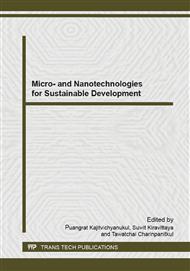[1]
Y.U. Jung, S.I. Oh, S.H. Choa, H.K. Kim, S.J. Kang, Electromechanical properties of graphene transparent conducting films for flexible electronics, Current Applied Physics, 13(2013) 1331-4.
DOI: 10.1016/j.cap.2013.04.017
Google Scholar
[2]
K. Chen, G. Lu, J. Chang, S. Mao, K. Yu, S. Cui, J. Chen, Hg(II) ion detection using thermally reduced graphene oxide decorated with functionalized gold nanoparticles, Analytical Chemistry, 84(2012) 4057-62.
DOI: 10.1021/ac3000336
Google Scholar
[3]
Y. Huang, X. Dong, Y. Liu, L.J. Li, P. Chen, Graphene-based biosensors for detection of bacteria and their metabolic activities, Journal of Materials Chemistry, 21(2011) 12358-62.
DOI: 10.1039/c1jm11436k
Google Scholar
[4]
I. Vlassiouk, P. Fulvio, H. Meyer, N. Lavrik, S. Dai, P. Datskos, S. Smirnov, Large scale atmospheric pressure chemical vapor deposition of graphene, Carbon, 54(2013) 58-67.
DOI: 10.1016/j.carbon.2012.11.003
Google Scholar
[5]
R.K. Paul, S. Badhulika, S. Niyogi, R.C. Haddon, V.M. Boddu, C. Costales-Nieves, K. Bozhilov, A. Mulchandani, The production of oxygenated polycrystalline graphene by one-step ethanol-chemical vapor deposition, Carbon, 49(2011) 3789-95.
DOI: 10.1016/j.carbon.2011.04.070
Google Scholar
[6]
S. Park, R.S. Ruoff, Chemical methods for the production of graphenes, Nature Nanotechnology, 4(2010) 217-24.
Google Scholar
[7]
J. Zhang, H. Yang, G. Shen, P. Cheng, J. Zhang, S. Guo, Reduction of graphene oxide via L-ascorbic acid, Chemical Communications, 46(2010) 1112-4.
DOI: 10.1039/b917705a
Google Scholar
[8]
J. Geng, B.S. Kong, S.B. Yang, H.T. Jung, Preparation of graphene relying on porphyrin exfoliation of graphite, Chemical Communications, 46(2010) 5091-3.
DOI: 10.1039/c001609h
Google Scholar
[9]
H. Bai, C. Wang, J. Chen, J. Peng, Q. Cao, A novel sensitive electrochemical sensor based on in-situ polymerized molecularly imprinted membranes at graphene modified electrode for artemisinin determination, Biosensors and Bioelectronics, 64(2015).
DOI: 10.1016/j.bios.2014.09.034
Google Scholar
[10]
N.S. Ismail, Q.H. Le, H. Yoshikawa, M. Saito, E. Tamiya, Development of non-enzymatic electrochemical glucose sensor based on graphene oxide nanoribbon-gold nanoparticle hybrid, Electrochimica Acta, 146(2014) 98-105.
DOI: 10.1016/j.electacta.2014.08.123
Google Scholar
[11]
L. Sansone, V. Malachovska, P.L. Manna, P. Musto, A. Borriello, G.D. Luca, M. Giordano, Nanochemical fabrication of a graphene oxide-based nanohybrid for label-free optical sensing with fiber optics, Sensors and Actuators B: Chemical, 202(2014).
DOI: 10.1016/j.snb.2014.05.067
Google Scholar
[12]
S. Spanò, G. Isgrò, P. Russo, M. Fragalà, G. Compagnini, Tunable properties of graphene oxide reduced by laser irradiation. Applied Physics A, 117(2014) 19-23.
DOI: 10.1007/s00339-014-8508-y
Google Scholar
[13]
L. Nan, L. Pengfei, X. Wei, X. Jie, Simple graphene chemiresistors as pH sensors: fabrication and characterization, Measurement science and technology, (2011) 107002-7.
DOI: 10.1088/0957-0233/22/10/107002
Google Scholar
[14]
P.K. Ang, W. Chen, A. Wee, K.P. Loh, Solution-gated epitaxial graphene as pH sensor, Journal of the American Chemical Society, (2008) 14392–3.
DOI: 10.1021/ja805090z
Google Scholar
[15]
D. Jung, M.E. Han, G.S. Lee, pH-sensing characteristics of multi-walled carbonnanotube sheet. Materials Letters, 116(2014) 57-60.
DOI: 10.1016/j.matlet.2013.10.095
Google Scholar
[16]
K. Priscilla, J. Li, W. Yu, W. Han, T.L. John, T. Chwee, P. Kian, Flow Sensing of Single Cell by Graphene Transistor in a Microfluidic Channel, Nano letters (2011) 5240-46.
Google Scholar
[17]
C. García-Aljaro, L.N. Cella, D.J. Shirale, M. Park, F.J. Muñoz, M.V. Yates, A. Mulchandani, Carbon nanotubes-based chemiresistive biosensors for detection of microorganisms, Biosensors and Bioelectronics, 26(2010) 1437-41.
DOI: 10.1016/j.bios.2010.07.077
Google Scholar
[18]
C. García-Aljaro, M.A. Bangar, E. Baldrich, F.J. Muñoz, A. Mulchandani, Conducting polymer nanowire-based chemiresistive biosensor for the detection of bacterial spores, Biosensors and Bioelectronics, 25(2010) 2309-12.
DOI: 10.1016/j.bios.2010.03.021
Google Scholar
[19]
Y. Huang, X. Dong, Y. Liu, L.J. Li, P. Chen, Graphene-based biosensors for detection of bacteria and their metabolic activities. Journal of Materials Chemistry, 21(2011) 12358-12362.
DOI: 10.1039/c1jm11436k
Google Scholar


